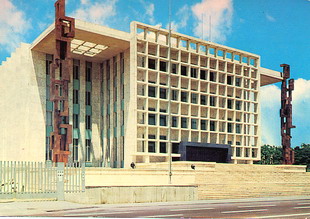
The People's Mojahedin Organization of Iran (PMOI), also known as Mojahedin-e-Khalq (MEK) or Mojahedin-e-Khalq Organization (MKO), is an Iranian dissident organization that was previously armed but has now transitioned primarily into a political advocacy group. Its headquarters are currently in Albania. The group's ideology is rooted in "Islam with revolutionary Marxism", but after the Iranian Revolution became about overthrowing the Government of the Islamic Republic of Iran and installing its own government. At one point the MEK was Iran's "largest and most active armed dissident group", and it is still sometimes presented by Western political backers as a major Iranian opposition group, but it is also deeply unpopular today within Iran, largely due to its siding with Iraq in the Iran–Iraq War.

The Reformists are a political faction in Iran. Iran's "reform era" is sometimes said to have lasted from 1997 to 2005—the length of President Mohammad Khatami's two terms in office. The Council for Coordinating the Reforms Front is the main umbrella organization and coalition within the movement; however, there are reformist groups not aligned with the council, such as the Reformists Front.
Presidential elections were held for the first time in Iran on 25 January 1980, one year after the Iranian Revolution when the Council of the Islamic Revolution was in power. Abolhassan Banisadr was elected president with 76% of the vote.

The Islamic Republican Party was formed in 1979 to assist the Iranian Revolution and Ayatollah Khomeini in their goal to establish theocracy in Iran. It was disbanded in 1987 due to internal conflicts.

On 28 June 1981, a powerful bomb went off at the headquarters of the Islamic Republican Party (IRP) in Tehran, while a meeting of party leaders was in progress. Seventy-four leading officials of the Islamic Republic of Iran were killed, including Chief Justice Ayatollah Mohammad Beheshti, who was the second most powerful figure in the Iranian Revolution. The Iranian government first blamed SAVAK and the Iraqi regime. Two days later, on 30 June, the People's Mujahedin of Iran was accused by Khomeini of being behind the attack. Several non-Iranian sources also believe the bombing was conducted by the People's Mujahedin of Iran.

The Organization of Struggle for the Emancipation of the Working Class, or simply Peykar, also known by the earlier name Marxist Mojahedin, was a splinter group from the People's Mojahedin of Iran (PMOI/MEK).

The Assembly for the Final Review of the Constitution also known as the Assembly of Experts for Constitution, was a constituent assembly in Iran that was convened in 1979 to condense and ratify the draft prepared beforehand for the Constitution of the Islamic Republic of Iran.
The Muslim People's Republic Party (MPRP) or Islamic People's Republican Party was a short-lived party associated with Shia Islamic cleric Shariatmadari. It was founded in 1979 during the Iranian Revolution as a "moderate, more liberal counterweight" to the theocratic, Islamist Islamic Republican Party (IRP) of Ayatollah Ruhollah Khomeini, and disbanded in 1980.
Following the Iranian Revolution, which overthrew the Shah of Iran, in February 1979, Iran was in a "revolutionary crisis mode" from this time until 1982 or 1983 when forces loyal to the revolution's leader, Ayatollah Ruhollah Khomeini, consolidated power. During this period, Iran's economy and the apparatus of government collapsed; its military and security forces were in disarray.

Parliamentary elections were held in Iran on 13 March 1980, with a second round on 9 May. They were the first elections to the Majlis since the overthrow of the Shah, and were contested to a considerable degree on a party basis.

Parliamentary elections were held in Iran on 8 April 1988, with a second round on 13 May. The result was a victory for leftist politicians who later emerged as reformists. The number of clerics elected to the Majlis was reduced by over a third.

Parliamentary elections were held in Iran in 1952 to elect the 17th Iranian Majlis.
A constitutional referendum was held in Iran on 2 and 3 December 1979. The new Islamic constitution was approved by 99.5% of voters.

Constitutional Convention elections were held in Iran on 3 and 4 August 1979. The result was a victory for the Islamic Republican Party. There were 10,784,932 votes cast in the elections, marking 51.71% turnout. Of all members elected, 68% were clerics.

Mojahedin of the Islamic Revolution Organization was an umbrella political organization in Iran, founded in 1979 by unification of seven underground Islamist revolutionary paramilitary and civil organizations which previously fought against the Pahlavi monarchy.
JAMA is an Iranian political party founded in 1964. The party which was mainly active between 1979 and 1981 and a junior partner in the Cabinet of Bazargan, had been outlawed throughout much of its history due to dissenting the rule of both Pahlavi dynasty and the Islamic Republic.

On 3 August 1979, Constitutional Convention election was held in Tehran Province constituency with plurality-at-large voting format in order to decide ten seats for the Assembly for the Final Review of the Constitution

On 3 August 1979, Constitutional Convention election was held in West Azerbaijan Province constituency with plurality-at-large voting format in order to decide three seats for the Assembly for the Final Review of the Constitution.

On 3 August 1979, a Constitutional Convention election was held in Isfahan Province constituency with plurality-at-large voting format in order to decide four seats for the Assembly for the Final Review of the Constitution.

On 3 August 1979, a Constitutional Convention election was held in Hamedan Province constituency with plurality-at-large voting format in order to decide two seats for the Assembly for the Final Review of the Constitution.















